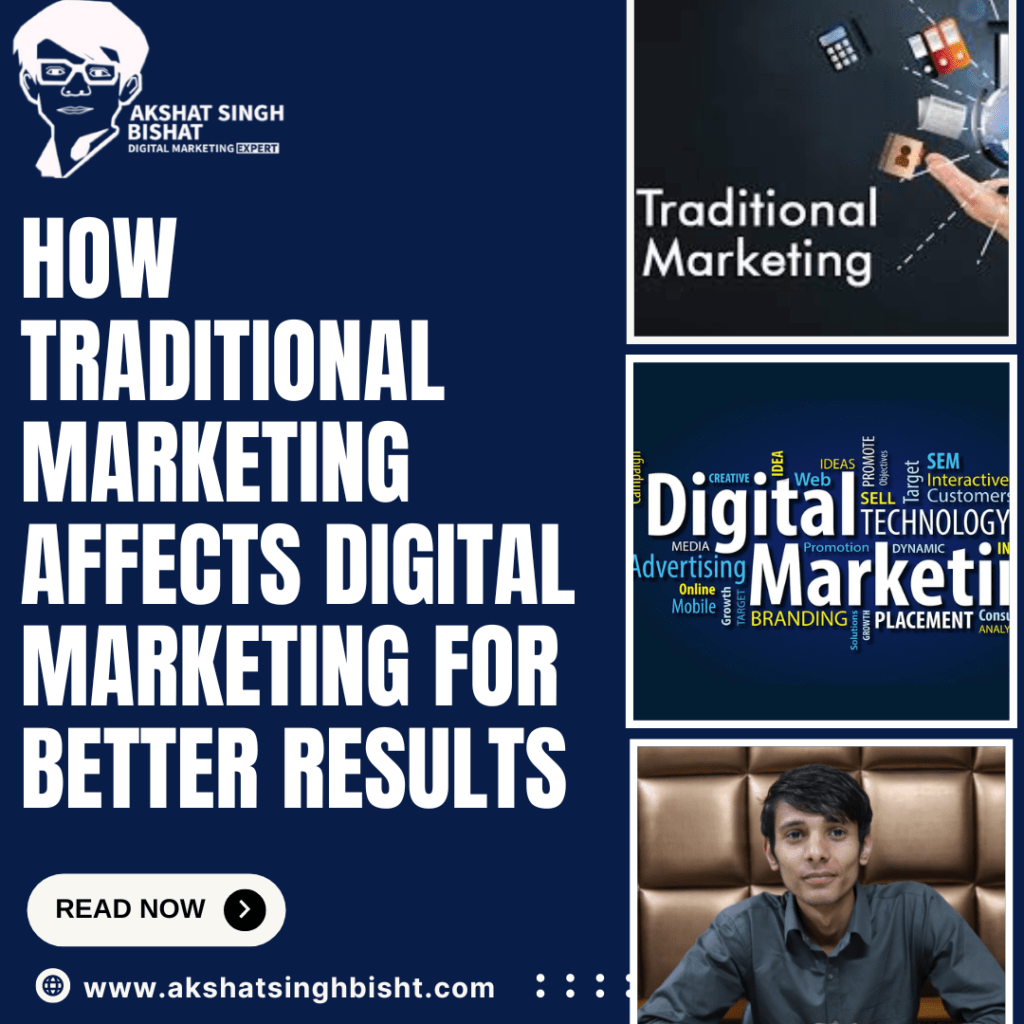In today’s rapidly evolving marketing landscape, understanding the interplay between traditional marketing and digital marketing is crucial for businesses aiming to maximize their outreach and impact. Traditional marketing encompasses various forms of advertising such as print media, television, radio, and direct mail. Digital marketing, on the other hand, includes strategies like social media marketing, search engine optimization (SEO), content marketing, email marketing, and more.
Despite the increasing dominance of digital marketing, traditional marketing remains relevant and influential. This comprehensive article explores how traditional marketing affects digital marketing for better results, examining various strategies, case studies, and the synergistic relationship between these two forms of marketing.

Traditional marketing refers to the conventional methods of promoting products and services. The key components include:
Print Media: Newspapers, magazines, brochures, and flyers.
Broadcast Media: Television and radio advertising.
Outdoor Advertising: Billboards, posters, and transit ads.
Direct Mail: Catalogs, postcards, and sales letters.
Telemarketing: Direct phone calls to potential customers.
Traditional marketing has evolved over the decades, adapting to changes in consumer behavior and technological advancements. Initially dominated by print and broadcast media, it expanded to include more targeted forms like direct mail and telemarketing.
Advantages:
Wide reach, especially among older demographics.
High trust and credibility associated with established media.
Tangible materials that can be physically interacted with.
Disadvantages:
Often expensive with high production and distribution costs.
Difficult to measure return on investment (ROI) accurately.
Less flexibility in modifying campaigns once launched.
Digital marketing leverages online platforms and technologies to promote products and services. The key components include:
Social Media Marketing: Utilizing platforms like Facebook, Instagram, Twitter, and LinkedIn.
SEO and SEM: Optimizing websites and running paid ads to improve search engine rankings.
Content Marketing: Creating valuable content to attract and engage customers.
Email Marketing: Sending targeted email campaigns to subscribers.
Affiliate Marketing: Partnering with other businesses or influencers to promote products.
Digital marketing has grown exponentially with the advent of the internet and mobile technology. From simple banner ads to sophisticated AIdriven personalized campaigns, it has transformed how businesses interact with customers.
2.3 Advantages and Disadvantages
Advantages:
Highly targeted and personalized campaigns.
Realtime analytics and measurable results.
Costeffective with flexible budget options.
Disadvantages:
Can be perceived as intrusive if not executed properly.
Rapidly changing landscape requiring constant adaptation.
Overreliance on technology can lead to technical issues.
3.1 Bridging the Gap: Integrated Marketing Communications (IMC)
IMC is the strategic integration of traditional and digital marketing to create a cohesive and effective campaign. It ensures that all marketing channels work together harmoniously to reinforce the brand message.
3.2 Case Studies of Successful Integration
Case Study 1: CocaCola’s “Share a Coke” Campaign
Traditional Marketing: Personalized Coke bottles with names, widespread TV and billboard ads.
Digital Marketing: Social media campaigns encouraging sharing of personalized bottles, usergenerated content.
Case Study 2: Nike’s “Just Do It” Campaign
Traditional Marketing: Iconic TV commercials, print ads in sports magazines.
Digital Marketing: Interactive social media campaigns, influencer partnerships, and a robust online presence.
3.3 Benefits of Combining Traditional and Digital Marketing
Enhanced Reach: Combining both strategies ensures a wider audience is reached.
Consistent Messaging: Reinforces brand message across multiple channels.
Improved Engagement: Diverse touchpoints increase customer engagement and interaction.
4.1 Brand Recognition and Trust
Traditional marketing builds brand recognition and trust, which are essential for successful digital campaigns. A strong offline presence boosts credibility online.
4.2 Leveraging Offline Data for Online Campaigns
Data collected from traditional marketing efforts, such as customer demographics and preferences, can be utilized to tailor digital marketing strategies more effectively.
4.3 Event Marketing and Digital Amplification
Events like trade shows and instore promotions generate buzz, which can be amplified through social media and email campaigns.
5: Digital Marketing Enhancing Traditional Strategies
5.1 RealTime Feedback and Adaptation
Digital marketing provides realtime feedback, allowing businesses to adjust their traditional marketing strategies quickly based on customer responses.
5.2 Enhanced Targeting and Personalization
Insights from digital analytics enable more precise targeting and personalization of traditional marketing efforts, such as direct mail campaigns.
5.3 CostEffective Testing and Optimization
Digital platforms allow for costeffective testing of different messages and creatives before rolling them out on a larger scale in traditional media.
6.1 Organizational Silos and Collaboration
Breaking down organizational silos and fostering collaboration between traditional and digital marketing teams is crucial for seamless integration.
6.2 Consistency in Branding and Messaging
Ensuring consistent branding and messaging across all channels can be challenging but is essential for a unified customer experience.
6.3 Measuring CrossChannel Success
Developing metrics and tools to measure the success of integrated campaigns across both traditional and digital channels is vital for assessing ROI.
7: Future Trends in Traditional and Digital Marketing Integration
7.1 Rise of Omnichannel Marketing
Omnichannel marketing, which provides a seamless customer experience across all channels, is becoming increasingly important.
7.2 Technological Advancements
Emerging technologies like augmented reality (AR), virtual reality (VR), and artificial intelligence (AI) are enhancing the integration of traditional and digital marketing.
7.3 Sustainable and Ethical Marketing
As consumers become more conscious of sustainability and ethics, integrating these values into both traditional and digital marketing strategies will be crucial.
Conclusion
In conclusion, the interplay between traditional marketing and digital marketing creates a powerful synergy that can lead to better results for businesses. By understanding the strengths and limitations of each approach and effectively integrating them, companies can enhance their reach, engagement, and overall marketing effectiveness. The future of marketing lies in leveraging the best of both worlds to create comprehensive and impactful campaigns.
Akshat’s passion for marketing and dedication to helping others has been the driving force behind AkshatSinghBisht.com. Known for his insightful perspectives, practical advice, and unwavering commitment to his audience, Akshat is a trusted voice in the marketing community.
If you have any questions simply use the following contact details.
